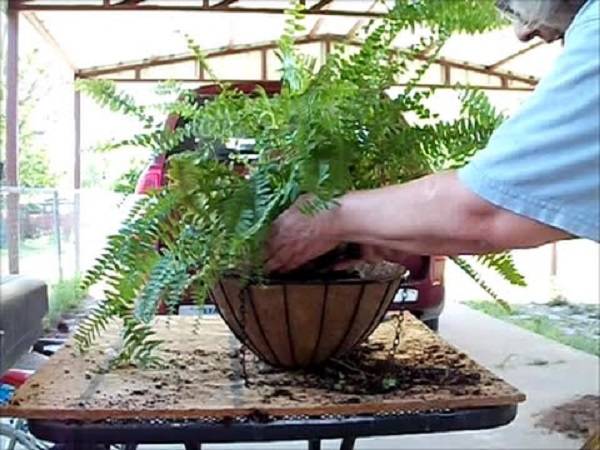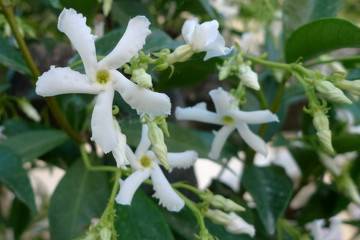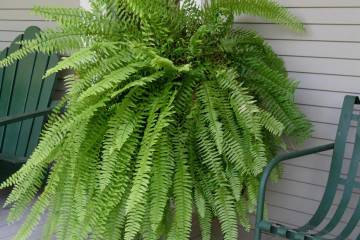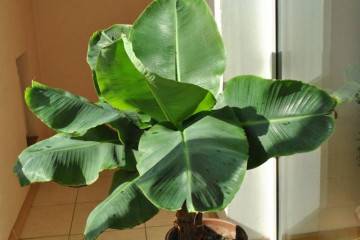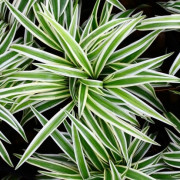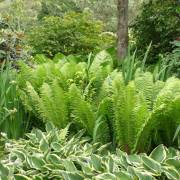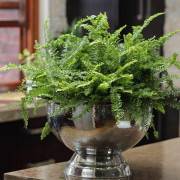How to grow indoor fern - home care
Content:
One of the most ancient plants is the fern. It appeared about 400 million years ago, when almost the entire planet was covered with these unusual and tall plants, similar in shape to trees. Currently, the majority is represented by terrestrial species. However, there are some growing on branches and even in water.
Indoor fern - benefits and harms at home
Home fern is perfect for keeping at home. It will not be difficult to grow it. Greens with original, elongated leaves will bring a little exoticism and warmth.
There are several main varieties:
- Nephrolepis is the most popular type for growing in an apartment. Noteworthy are the varieties Pulmosaс, Rooseveltia with lobed leaves, Can Can with corrugated leaves, Norwoodiiс with leaves in the form of feathers and frills, Whitmanii with thin and curly foliage.
- Maidenhair is another graceful, compact plant. Its height is from 30 to 40 cm. It has a fine structure. The leaves are deep green in color and look like ginkobiloba leaves. It can double in size during the season. Differs in very fast regeneration. It did not become widespread as the first species due to its high sensitivity to changing places and environmental conditions.
- Platycerium moss is perhaps the most exotic of all indoor ferns. Leaves are up to 70 cm long, gray-green in color. Their external form is similar to moose horns. Under natural conditions, they are able to cling to the branches, forming a vessel in which sedimentary water is collected for irrigation. Old leaves go to humus and also end up in these containers. Their purpose is to feed the root system.
- The round-leaved pellea came from New Zealand. In the homeland of the plant, the soil is enriched with various limestone rocks. The bright green leaves are rounded. The shrub is low. Grows up to 30 cm.
- Asplenium nidus stands out with shiny, luscious green foliage, which forms a funnel-shaped rosette. They differ based on the variety. They can be in the form of a wave, with teeth, wide or narrow, up to 1 m long.
Decorative value
The house fern is an ornamental plant. Depending on the variety, the desired effect is obtained by complementing the interior. In any case, the plant decorates the room, brings exotic and grace to it. They also use it in landscape design, creating single or prefabricated compositions.
Benefits and harms for the inhabitants of the house
Many legends and superstitions have been created about this plant. But both the benefits and the harm that fern can bring have already been scientifically proven.
Home benefits:
- absorption of toxins;
- humidification of the air due to the intense movement of water in parts of the plant;
- absorption of radiation from household appliances, such as microwave.
A possible harm is that placing the flower in the bedroom next to the bed can cause a headache, since the plant emits carbon dioxide at night. A reaction in allergy sufferers is also possible.
Can you keep a fern at home? Sure you may. You just need to put it in the right place, taking into account the above information about the benefits and potential harm.
Poisonous properties of some species
It is worth talking about some of the poisonous varieties. Their properties are used in pharmacology for the preparation of medicines.
The poisonous effect is exerted by substances that contain Ostrich, Shitovnik, Orlyak. You can even poison yourself with the milk of an animal that ate the leaves of a flower.
Is it possible to keep a fern in an apartment
Now a little about the esoteric background of keeping a fern at home. There is an opinion that it is impossible to grow a plant in an apartment, others say the opposite. He is credited with both positive and negative effects on the living person. For example, they say that the plant contributes to the creation of harmony and mutual understanding in the family, helps to spend less money. Especially suspicious do not keep this flower in the house because of the possibility of attracting illness, misfortune.
Florists do not take into account any superstitions and successfully use plants to create luxurious compositions.
How to plant a fern in a pot
Most of the representatives of this culture live in forests, which is why they love moist, humus-rich soil. The right decision is to plant a flower at home in a special soil, for example, for palms and ferns, bought in a store. When self-cooking, compost from foliage must be added. This increases the humus content. Good soil should absorb moisture and allow it to pass through so that stagnation does not form.
The houseplant fern prefers medium to high acidity. To protect against pests, peat, sand (exceptionally large), compost from leaves, turf are added to the ground. Place in a preheated oven for 1 to 1.5 hours.
Fern transplant
The root system is growing rapidly, so you will have to change the pot often - once a year with normal, healthy development of the flower. Stems and leaves also grow quickly, corresponding to the roots. For this reason, soil depletion occurs.
The best ceramic pot. It both absorbs and gives off moisture. The capacity should be heavy, even weighty, since the weight of the fern becomes larger with age and it grows asymmetrically.
The transplant takes place in several stages:
- The plant, without getting out of the pot, is placed in a larger container. Fill it with water. Withstand 20 minutes, after which the plant is turned over with the tips of the leaves down and carefully removed from the planting pot (along with the soil).
- Drainage is laid out on the bottom of the new container (from brick chips or small pebbles). Land is poured up to the middle. Place the fern in a pot and sprinkle gently with soil. The neck of the root is not touched and is left above the soil surface.
- Abundant watering is carried out.
- Spill again after two weeks, even if the top layer is not dry.
After the plant has completely taken root in a new place, you need to take care of it in the usual way.
How to care for a home fern
The reputation for the capriciousness of the fern plant (care, accompanied by various difficulties) is fiction. In fact, caring for a fern is simple and brings a lot of pleasure, because the miracle plant is responsive to proper watering, feeding and prettier right before our eyes.
Most forest species love shade and warmth.A suitable place for their location in the apartment is the west or east side. A spacious, well-lit kitchen will do. Artificial shading should be created on the south window, especially in spring and summer at lunchtime.
Features of caring for a forest fern in an apartment
An important part of fern care is regular leaf spraying and frequent watering. The plant is sensitive to the drying out of the substrate, but at the same time it does not like waterlogged soil.
During growth, watered every 2 days, using settled water at room temperature. The water must be soft. The plumbing is harsh in this respect. It usually contains a large amount of calcium carbonate. Standing rainwater is ideal.
Fertilize the plant from early spring to early autumn. One application of top dressing per month is enough. It is better to purchase store-bought fertilizers intended for ferns rather than universal fertilizers.
Comfortable temperature during the growing season - from +18 to +21 degrees. In winter, a little lower - up to +15, +18. Fern in home care requires high humidity - more than 60%. Therefore, it is not placed next to heating devices. Otherwise, the foliage will begin to dry.
The fern just loves the spraying procedure. It is carried out systematically. It is good to place a container of water next to it, such as a vase or jug. This will serve as an additional source of air humidification.
Reproduction
Breeding a fern by sowing spores is a difficult task. Even experienced growers do not use it. Of course, it is interesting and informative to observe how plants develop from the very beginning, in other words, to grow from the "embryo". When choosing this method, you should know that at some stages of the growth of young plants, you need to take into account all the features of how to care.
There is another, simpler way - reproduction by rhizomes, in particular by dividing the bush. It is suitable for all plants with a developed and branching root system. The rhizome is divided into the required number of parts on which there are heads - points for the attachment of leaves. There should be at least a couple of shoots on the plot. They are seated in prepared containers.
The third way is with the help of shoots. Choose arrow-shaped. They are bent to the surface of the ground and fixed. After some time, the process takes root. At this stage, the plant is separated from the mother plant.
The fourth method is with the help of lateral buds, which are separated during the formation of roots on them. Young, newly appeared shoots are transferred to greenhouse conditions with high humidity and a temperature of at least +23 degrees. Such conditions can also be created in plastic containers. When the first leaves are formed, they are seated in pots.
What to do if fern leaves dry
Indoor fern requires proper care at home. Therefore, it is sick, as a rule, due to non-compliance with the basic rules for growing. Particular attention should be paid when the leaves begin to turn yellow (first of all, the tips), and the entire surface fades, loses its decorative effect.
There are several reasons for this problem. This is both excessive watering, which leads to the appearance of rot on the root system, and an insufficient level of air humidity. Drying of foliage can occur due to pest damage.Although they are not very common in the history of ferns. This is the exception rather than the norm. Insufficient watering is another reason for leaf drying.
If the fern is kept in low temperature conditions for a long time, fungal infection may occur. This is indicated by the formed brown or gray spots of an oval or round shape. These spots can be in the form of a border framing the leaf.
Among insect pests, scale insects are the most widespread. They are located on the back of the leaf and drink the sap of the plants. After that, yellow spots form on the leaves. When the leaf turns yellow all over, it dies off.
How to deal with yellowing of leaves
So, there are several reasons why fern leaves can turn yellow. What measures should be taken in each case?
Yellow leaves must always be removed. Cut to the base. In the presence of a fungus, after elimination of all affected foliage, spraying with a fungicidal agent is carried out.
When infected by insects, all the leaves are cut off, and the fern itself is treated with an insecticide.
In case of insufficient watering, the plant is immersed together with the pot in a large container of water and left for 20 minutes. The procedure should be repeated 2-3 times over several days.
Ferns are easy to grow. It is a beneficial plant and it is scientifically proven. Subject to simple conditions, the fern will delight with its evergreen look and add exoticism to the surrounding space.



